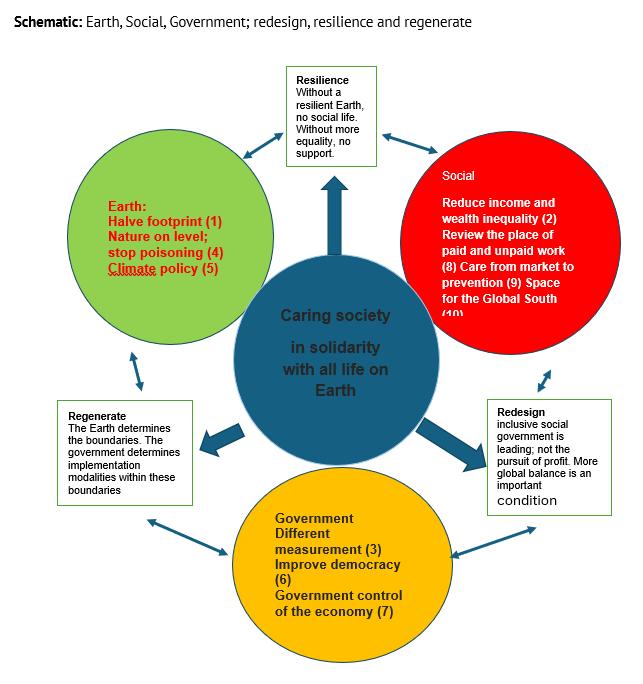In solidarity with all life on earth
De originele Nederlandse versie vindt u hier
We have major concerns for tomorrow. Socially and ecologically we are on the wrong path. The longer necessary systemic changes are delayed, the longer society and nature will need to recover sufficiently. In the ten domains mentioned below, we outline the background of these concerns, starting with Why, and we indicate what needs Less, and also what needs More on the path to a caring society. A caring society is one in which we care for each other and for the planet. Everyone, worldwide, should be able to lead a good life on a resilient planet. That’s where we want to go. The ten paths are interconnected and have, both individually and as a whole, the characteristics of a major transition. The paths are derived from a more detailed article on our site (in Dutch). Together, the totality of these paths makes the caring society conceivable. On some paths, many steps have already been taken. Of course, more points of less/more can be named for each path, but we think the image below provides sufficient direction.
1. Halving the national footprint but in a global perspective on the way to Footprint Justice
a. Why: our much too large global footprint makes life impossible in the long term or at least very difficult. We are hollowing out the planet; we are consuming it.
b. Less: therefore we must (on average) produce and consume much less. The current ecological footprint is a global average of 2.8 ha per world inhabitant. This must be reduced to the sustainable level of 1.6 ha per person. Less fossil energy, unsustainable agriculture, animal products, excessive fishing, non-repairable goods, unsustainable clothing. Less war production.
c. More: free time, education, time for upbringing and informal care, cleaner air, etc., give the National Climate Platform a (a Dutch institution) prominent role, stimulate grassroots initiatives.
2. Reduction of inequality.
a. Why: great inequality leads to status competition, unnecessary consumption, structural poverty, major political influence of the super-rich, and internationally to conflicts between countries.
b. Less: excessive wealth, large pay differences, large wealth inequality, tax havens, gender inequality. Great inequality leads to lack of initiative.
c. More: universal basic services, raising the minimum wage, higher inheritance and wealth taxes and more progression in income tax. International cooperation.
3. Measuring differently; GDP agnostic.
a. Why: GDP is too limited a measuring instrument; it only measures monetary transactions and gives wrong growth incentives.
b. Less: focus on increasing GDP as a measure of prosperity. Less attention from politics and media for GDP. Strongly devalue GDP as the unique policy goal of the economy.
c. More: policy aimed at human and ecological well-being. Improve the Broad Prosperity Monitor ( an annual government document) and make it the starting point for all policy. Growth is not always reprehensible; for example in services or in situations of underdevelopment. Evaluate and improve annually.
4. Bringing nature to an adequate level and stopping the poisoning of the planet.
a. Why: nature and biodiversity are declining rapidly but are a vital element in survival; for example, the decline of insect populations endangers pollination. Natural values have dropped to critical levels. Species are disappearing at an unprecedented rate.
b. Less: waste production and the spread in nature. Pesticides mainly combat nature. Less intensive agriculture, desiccation, and fragmentation of natural areas.
c. More: develop climate-resilient nature, more regenerative agriculture, rewilding, more forests; more faith on ecosystem processes; more climate adaptation, more attention to climate in the Global South. Without international justice, there is no regional justice. More nature with the status of a legal entity.
5. Climate politics, 100% sustainable energy, substantial energy conservation, and different mobility.
a. Why: the carbon economy is the main cause of climate disruption.
b. Less: energy use. Ending the use of fossil fuels is crucial to limiting further climate change. Our carefree mobility also contributes to unbridled use of resources and CO2 emissions. Electric cars are not climate neutral.
c. More: urgency with the energy transition. The faster, the cheaper. More insulation, electrification, and sustainable energy for businesses and citizens. Progressive car and flight taxes and more affordable public transport.
6. Improve democracy; strive for a new national pact.
a. Why: trust in democracy is declining rapidly, thereby creating space for populism and nonsense stories.
b. Less: plans for a maximum of 4 years, less politics aimed at vote maximization, less lobbying activities. Populism leads to postponement and abandonment of necessary choices.
c. More: work on a new social pact for sustainable improvement, citizen participation, citizens’ councils, increase the power of the European Parliament, develop multiple-choice referendums (preferenda).
7. Economic control shared among government, commons/civil society, and market.
a. Why: in the neoliberal period, too much power has been transferred from the government to the market. The power of shareholders does not lead to socially optimal decisions. It promotes self-enrichment and inequality.
b. Less: influence of (large and tech) companies, less market in the social sector (care, housing, health), international evasion possibilities, less influence of large banks on the economy, less influence of orthodox economic theory.
c. More: focus on the common good, determined by citizens in a dynamic dialogue, with contributions from commons, government, and market; more emphasis on social and ecological returns (based on, among other things: the polluter pays; regenerative agriculture); redesign of institutions (monetary system, tax base, economics education, economic democratization).
8. Revising the place of paid and unpaid labor.
a. Why: labor is necessary to keep society running. This applies to both paid and unpaid labor, but leaving the place of labor to the market leads to appalling conditions; inequality and discrimination.
b. Less: room for labor exploitation, for hierarchical labor relations, having to work as a duty. Less flex-labor, migrant workers.
c. More: job security becomes the starting point, everyone has the right to work, with room for gender differences, more reduced working hours. Unpaid labor gets an equal place to paid labor.
9. Care from market to prevention.
a. Why: the privatization wave has turned care institutions into profit-oriented enterprises. Care has become a product with a market value.
b. Less: market forces, care is not profit-oriented, less bureaucratic controls. Less large-scale care.
c. More: attention to prevention, to everyone’s access to good care, to affordable care.
10. Giving space to the Global South.
a. Why: reverse development aid (more money flows from South to North than vice versa). The structural position of the Global South therefore remains worrying. Opportunities are hardly created.
b. Less: (neo)colonialism, unequal exchange, continued exploitation, less burdening the Global South with our mess.
c. More: contributions from rich countries in climate adaptation and mitigation, debt cancelling, more trade on equal footing, more international structures aimed at inclusive development.
On the way to that caring society, conflicts are resolved non-violently. This can be done, for example, through mediation, reconciliation commissions, and legal processes, such as the case at the International Court of Justice on Climate Justice. For conflicts between countries, a pool of experts at the UN can also be available, from which the countries concerned can each choose two or more people to mediate.
The coherence of the ten paths is important. Of course, steps can be taken independently in the energy transition, in changes in the tax regime, or in regenerative agriculture. The changes are all chains of processes that are dependent at multiple points and connected to other chains. But, central is that the direction of the changes comes to the government. Market forces aimed at profit maximization can never lead to the best for the planet or to the necessary reduction of inequality. It is important to continue asking questions in each process, to strive for shared values, to show what changes, improves, and to provide certainties to those who have contributed least to the current crises (the bottom of society, the bottom of the world). The coherence in the system ultimately works reinforcing.
Conclusion:
When society takes initiatives both top-down in political policy and from below, and develops plans and projects, then the caring society is not a distant utopia. In the hopeless period of the 1930s, the ambitious Plan of Labor (by the Dutch socialist party) was launched. In the post-war period, this was largely realized. The slogan of the Plan is also usable again now: It must be done, it can be done, forward with the Plan.

Platform Duurzame en Solidaire Economie (main author John Huige)
(Platform Fair and Green Economy)


